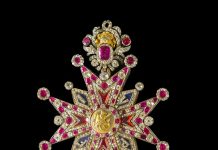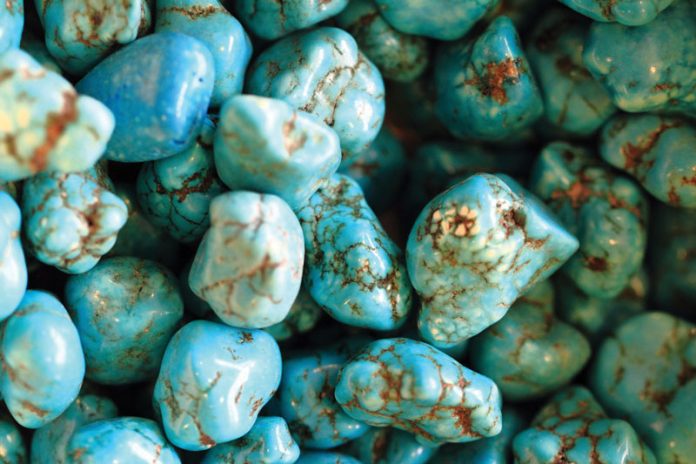
Turquoise in America is usually associated with the Native peoples of the Southwest. And with good reason. For more than a thousand years, the Indigenous people of this part of the U.S. have had a profound relationship with turquoise. The stone’s stunning colors, most commonly blue to green, hold the key to what makes it so special.
Turquoise Facts
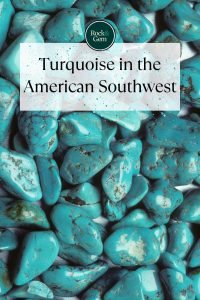
Real turquoise, not rocks dyed to look like turquoise, can be found in different parts of the world, but in North America, the desert Southwest provides the greatest source. The gemstone is formed only in arid climates when meteoric water originally from rain or melted snow percolates through voids in course copper-rich igneous rock. Turquoise results from the chemical reactions of the minerals that fill the void within the host rock, which is usually rhyolite, limestone, quartz, or chert. The color of turquoise produced is reflected by the amount of metal in the host stone. A higher incidence of copper produces a bluer turquoise, while more iron results in green coloration. High levels of zinc give the turquoise a yellower tone.
Turquoise has been mined in the U.S. for hundreds of years, with more than 400 turquoise mines in operation in Arizona, New Mexico, Nevada, Colorado, and California over the past two centuries. The first turquoise miners were the Pueblo peoples, who used stone mauls, axes, and chisels to remove it from its host rock. In 1908, turquoise became popular with tourists visiting the Southwest, and prospectors came to the area to mine it. The stone’s popularity soared to new highs in the late 1920s and early 1930s, resulting in the operation of more mines.
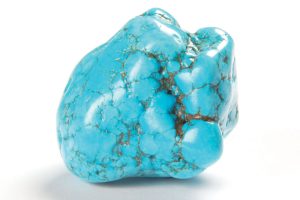
Colors of Life
While non-Native visitors to the Southwest were attracted to turquoise because of its bright color, the stone had—and still has— significant symbolic meaning to the Navajo, Zuni, Apache, O’odham, and other tribal nations. The color of turquoise is what sets it apart from all other stones in these Native cultures. “Turquoise was always appreciated by indigenous peoples as the blue ‘skystone’ and the green ‘mother earth,’” says Jacob “Joe Dan” Lowry, executive director of the Turquoise Museum in Albuquerque, N.M. “Other stones cannot match the colors of our created world.” Native people view turquoise as linked to the sky, water, and earth, making it representative of crucial elements of the natural world. The stone’s connection to water is especially strong, which gives it great significance in a land where water is both scarce and precious. For farming nations like the Navajo and Pueblo peoples, water was crucial for the survival of their crops and livestock.
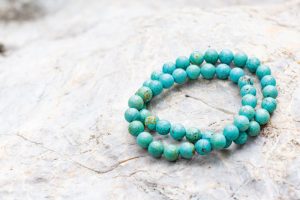
Everyday Life & Ceremony
Given this symbolism, it’s not surprising that turquoise appears in both everyday Native life as well as in ceremonies. Turquoise jewelry is commonly worn at Native American cultural and civic events, and the Zuni use turquoise in prayer. In fact, for most Pueblo people, wearing turquoise is a way of asking for rain. For the Navajo, turquoise is closely linked to health, safety, and protection, and is also associated with the sun; the direction of the South; and Mount Tayler, a sacred mountain in New Mexico that plays a role in the Diné creation story. Turquoise is still used in Navajo ceremonies, including puberty rites, weddings, initiation, and healing. Navajo babies are given their first turquoise beads shortly after birth.
Turquoise & The Creation Myth
At the Acoma Pueblo in New Mexico, the oldest continuously inhabited community in the U.S., turquoise is an important stone. According to TSkies.com blogger Jeffrey Bacon, the creation myth of the Acoma reflects a widespread sentiment about turquoise in the Southwestern U.S. “According to the Acoma, the Creator, Iatiku, taught them to make turquoise and shell beads that had great power, making their wearer attractive and beloved,” said Bacon. The O’odham people of southern Arizona associated turquoise with strength and healing, while for other tribes, turquoise represented strength, skill, and even invincibility. “The Apache associated turquoise with rain at the end of the rainbow,” said Bacon. “They attached pieces to their bows to become precise and invincible hunters and warriors.” The Hopi considered turquoise to be the excrement of the lizard who travels between “the above” and “the below,” and Hopi miners carried turquoise to give them security and strength in their work, according to Bacon.
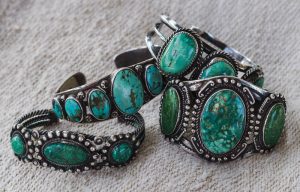
Wearing Turquoise
The Indigenous peoples of the American Southwest have become synonymous with turquoise and its use in various types of jewelry. For more than 1,000 years, jewelry adorned with this stone has been an integral part of the adornments worn by the peoples of this part of the U.S. Because of the significance of turquoise, it is often added in even a small way to jewelry made mostly from other stones. The tradition of using turquoise in bead necklaces, bracelets, earrings, and as inlays on shells continues today. Shells, once acquired through trade with coastal societies, are often paired with turquoise in jewelry because both are symbols of water.

Making Jewelry
Of all the Southwestern nations, Santo Domingo Pueblo artists are reported to produce the most traditional turquoise jewelry. Located 25 miles southwest of Santa Fe, New Mexico, the Santo Domingo Pueblo is home to around 2,500 tribal members and some of the most noted artists who work with turquoise. The Santo Domingo people have a long tradition of designing jewelry, and their creation story includes the making of jewelry. The Kewa, the people of this pueblo, are most famous for their hand-rolled heishi beads, many of which are made with turquoise. While turquoise jewelry has long been a part of traditional Southwestern culture, Native artists began making jewelry for sale to the non-native market at the turn of the 20th century. Tourists arriving in the Southwestern states were looking for souvenir jewelry to take home with them and were willing to pay well for it. The area became known for its turquoise and the beautiful jewelry that held it. In turn, turquoise became even more common within the Native cultures themselves.
“Turquoise has gained a greater appeal and allure since the 19th and 20th centuries, and into the 21st century,” says Lowry. “This greater appeal was due to outside cultures writing about turquoise and the Native American cultures in a variety of literature. Marketing and tourism played their part in growing the already established Native turquoise traditions, and finally, the 20th-century jewelry market and movie industry completed a forever love of turquoise through all generations of most Native culture.”
This story about turquoise previously appeared in Rock & Gem magazine. Click here to subscribe. Story by Audrey Pavia.




